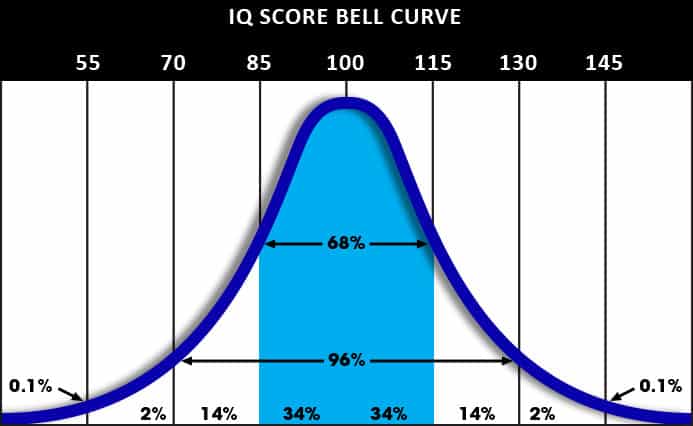When people talk about “average” human intelligence, statistically they’re talking about the mean of scores made available from scientifically accepted IQ tests. It’s been discovered that over the course of time human beings have gotten smarter, a discovery known as the Flynn Effect. With this increase in IQ it means that the “average human IQ” we see today is significantly higher than it was a hundred years ago. Scores are evaluated periodically, and the tests adjusted, so that the average score on most intelligence tests such as the Wechsler Adult Intelligence Scale and the Stanford-Binet Intelligence Scale’s mean score is 100 and maintains the standard IQ distribution known as the IQ bell curve.
The distribution of the scores on these tests fall uniformly from each side of the mean and form what is known as the IQ bell curve. This distribution of scores is known as a standard distribution, seen in the graph below of the score distribution for the Wechsler intelligence tests.

The meaning of the IQ bell curve
The IQ bell curve helps categorize where people fall along the scale of intelligence and does so in a neatly compartmentalized way. If you look at the graph above, you can see that there are equal parts above and below the mean of 100. Roughly 68% of humans will have IQ scores that fall between 85 and 115, or one standard deviation above or below the average human IQ. Expanding the curve out a little further to two standard deviations, you’ll find that over 95% of people will fall between 70-130 on the IQ scale. The further out you go you will find fewer and fewer people, as only 4.2% of IQ scores fall between 55-70 and 130-145. The next level of scores above or below these levels is extremely rare, as people with IQs below 55 are intellectually impaired, while people with IQs above 145 are exceptionally gifted and often considered geniuses.
Typically, an individual who completes an intelligence test with a cumulative score between 90 to 109 would be classified as having an average IQ. Roughly 50% of the population falls into this category. In general, IQ scores are categorized as follows for the two most popular IQ tests, the Stanford-Binet and Wechsler Tests.
Wechsler IQ Scale
[table id=11 /]
Stanford-Binet IQ Scale
[table id=10 /]
Why are the scales slightly different for these two popular IQ tests? The answer is that they have different standard deviations. The Wechsler tests have a standard deviation of 15 while the Stanford-Binet tests have a standard deviation of 16, meaning what constitutes an average IQ score on each is slightly different, and also it makes for a slightly wider distribution if you were to graph the Stanford-Binet’s IQ bell curve compared to that of the Wechsler test.
Do IQ scores vary around the world?
This, as you might imagine, is a very controversial topic. IQ testing alone is a source of controversy as people constantly debate how to measure all the various facets that make up a person’s intelligence. That said, some scientists have spent time trying to record IQ test scores from around the world, the most notable being the work of controversial English psychologist Richard Lynn. While his work has many opponents, it’s one of the few publicly available sources of information on the subject, and you can see more of those scores on our IQ score range page. For what it’s worth, the average IQ score in the United States from Lynn’s work was a 98, two points below the global average. Hong Kong and Singapore tied for first within his research with an average IQ score of 108.
What does my IQ score mean?
It’s important to note that the scores above are designed to reflect overall intelligence, while it’s generally believed that there are many different types of intelligence that an individual may possess. So while someone may be seen as having a low IQ by their overall score, it’s quite possible that these people may be test scores that show average or even well above average in certain types of intelligence. Many modern tests of intelligence contain a variety of subtests to help identify specific types of cognitive abilities like information processing, visual-spatial reasoning, and fluid intelligence.
Can you improve your IQ?
People with wide ranges of IQs have proven to be wildly successful in all walks of life. However, some people who have received a below average IQ score or even an average IQ score have sought to improve their intelligence score. While it’s generally accepted that genetics affect intelligence, people can take matters into their own hands to some extent to improve their IQ. You can read the link for specific tips, but in general, being healthy and exercising your brain much like you would your body, can help a person achieve a substantial improvement in cognitive function and overall intelligence.
What is considered an accurate IQ test?
While quick IQ tests like the one available on this site can provide you with a generalized idea of your intelligence, it is not an official score that can be used to gain entry to high IQ societies like Mensa, or used for career or educational screening purposes. There are a wide variety of generally accepted IQ tests that you can sign up for and have administered by a psychiatrist or other trained professional. It’s important to note that certain tests are more or less focused on verbal and language skills to provide scores that are not impacted by someone’s language skills or culture, particularly for people taking the test in a second language.
